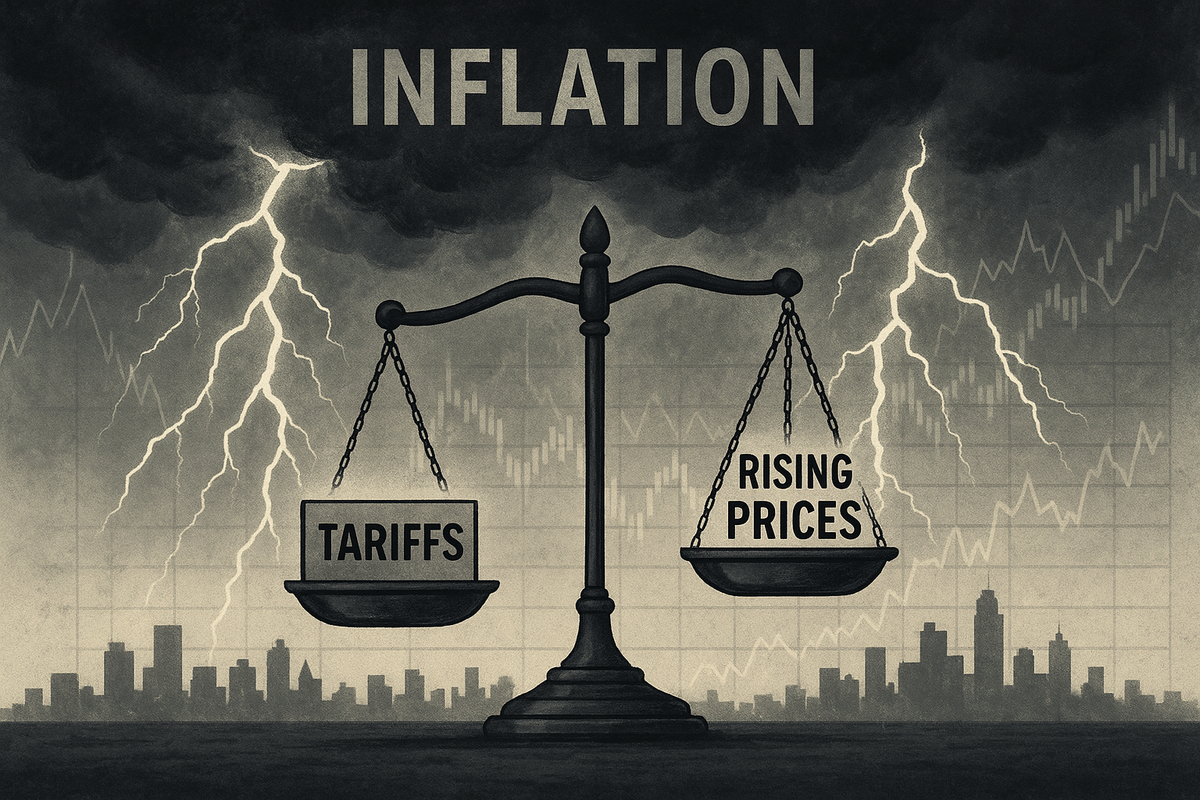
The specter of persistent inflation looms large over the global economy, with recent data revealing a significant surge in both year-ahead and five-year inflation expectations. This escalating concern is not merely a statistical anomaly but a tangible threat to consumer purchasing power and economic stability, forcing central banks to reconsider their monetary policy trajectories. At the heart of this inflationary pressure, a critical factor has re-emerged: the enduring impact of President Trump's tariffs, which are demonstrably driving up average selling prices across a multitude of sectors and embedding higher costs into the very fabric of the supply chain.
This confluence of rising inflation expectations and tariff-induced price hikes presents a complex challenge for policymakers and a volatile landscape for financial markets. Consumers are already feeling the pinch, with declining sentiment and increased financial stress, while businesses grapple with the difficult decision of absorbing escalating input costs or passing them on to an already strained populace. The immediate implications are clear: a prolonged period of elevated interest rates, increased market volatility, and a potential slowdown in economic growth as the world grapples with an inflation problem that appears more entrenched than previously anticipated.
The Unanchoring of Expectations: Tariffs' Role in Price Escalation
The current inflationary environment is characterized by a worrying trend: the unanchoring of long-term inflation expectations. Consumer surveys paint a stark picture, with the University of Michigan's August 2025 year-ahead inflation expectations rising to 4.9% and five-year expectations climbing to 4.0%. Similarly, the New York Federal Reserve's July Survey of Consumer Expectations reported one-year ahead expectations at 3.1% and five-year ahead expectations at 2.9%. These figures, significantly above central bank targets, suggest a growing public belief that inflation is here to stay, a sentiment that can become a self-fulfilling prophecy.
A major contributor to this persistent price pressure, and a key player in the current economic narrative, is the re-evaluation of President Trump's tariffs. Initially implemented with the stated goal of protecting domestic industries and jobs, these tariffs – essentially taxes on imported goods – have increasingly been passed on to American businesses and, ultimately, consumers. While some businesses initially absorbed these costs, recent data indicates a "tipping point" has been reached. The U.S. International Trade Commission found that in 2021, tariffs increased prices between 1.7% and 7.1% in the ten most affected sectors, including apparel, car parts, furniture, and computer equipment. For instance, a Playstation 5 could see its price jump significantly due to tariffs, and a 25% auto tariff could increase the price of a 2025 SUV made in Mexico from $31,395 to $39,244.
This direct cost increase has a cascading effect on key inflation metrics. The Consumer Price Index (CPI), which measures the average change in prices paid by urban consumers, has shown a discernible impact. The July CPI report indicated that headline CPI rose 0.2% monthly and 2.7% year-over-year, with core CPI (excluding volatile food and energy) jumping 0.3% monthly and 3.1% year-over-year – its fastest annual pace in five months. This acceleration in core CPI, particularly in categories like furniture, appliances, and recreation goods, signals that businesses are now more readily passing on tariff-related costs. The Producer Price Index (PPI), an early indicator of future consumer inflation, surged by 0.9% in July, the largest monthly jump in over three years, with the annual rate reaching 3.3%. Core PPI rose by 3.7% over the year, its highest annual rise since April 2021. This surge in PPI, especially for tariff-exposed goods, underscores the mounting cost pressures in the supply chain. The Federal Reserve's preferred inflation gauge, the Personal Consumption Expenditures (PCE) price index, also ticked higher, with core PCE rising 2.8% in the past year. Projections from institutions like J.P. Morgan and the Federal Reserve Bank of Boston suggest that proposed and existing tariffs could add significant basis points to core PCE inflation, further solidifying the link between trade policy and domestic price levels.
Navigating the Headwinds: Potential Winners and Losers
In an environment of persistent inflation fueled by tariffs, the landscape for public companies becomes sharply divided, creating both potential winners and significant losers. Companies with strong pricing power, diversified supply chains, or those operating in sectors shielded from import competition may find themselves in a more advantageous position. Conversely, businesses heavily reliant on imported goods, those with thin margins, or those operating in highly competitive consumer markets are likely to face considerable headwinds.
Potential "winners" in this scenario could include domestic manufacturers who produce goods that directly compete with tariff-affected imports. For example, U.S. steel producers like Nucor Corporation (NYSE: NUE) and Cleveland-Cliffs Inc. (NYSE: CLF) could benefit from reduced foreign competition and higher domestic steel prices, although they also face increased input costs for other materials. Companies with robust domestic supply chains or those that have successfully near-shored or re-shored production could also gain a competitive edge by avoiding tariff-related costs and supply chain disruptions. Furthermore, businesses providing essential services or goods with inelastic demand, such as utilities or certain healthcare providers, may be better positioned to pass on increased costs to consumers without a significant drop in demand.
On the other hand, the list of potential "losers" is extensive. Retailers and consumer goods companies that import a significant portion of their inventory, such as Walmart Inc. (NYSE: WMT), Target Corporation (NYSE: TGT), or apparel brands like Nike, Inc. (NYSE: NKE), could see their margins squeezed as they absorb tariff costs or risk losing customers by passing on full price increases. Manufacturers heavily reliant on imported components, such as automotive companies like General Motors Company (NYSE: GM) or electronics giants like Apple Inc. (NASDAQ: AAPL), face higher input costs, which can lead to increased production expenses and potentially higher consumer prices for their products. The automotive sector, in particular, has been highlighted as vulnerable, with a 25% auto tariff potentially adding thousands to the price of a new car. Companies in the food and beverage industry, importing goods like coffee or spirits, could also see increased costs impacting their profitability and consumer prices. Ultimately, any company with a significant exposure to international trade, particularly with countries targeted by tariffs, will need to strategically adapt to mitigate the financial impact.
Broader Implications: A Shift in Economic Tides
The persistent inflation concerns, exacerbated by the tariff regime, signal a significant shift in broader industry trends and economic policy. This event is not an isolated incident but rather fits into a larger narrative of deglobalization and the re-evaluation of international trade relationships. The era of consistently low inflation, often attributed to globalized supply chains and efficient production, appears to be receding, replaced by a more volatile and cost-intensive environment.
The ripple effects on competitors and partners are substantial. Companies that have built intricate global supply chains over decades are now forced to re-evaluate their strategies, potentially leading to reshoring efforts, diversification of suppliers, or increased investment in automation to offset rising labor and import costs. This could create new opportunities for domestic logistics and manufacturing sectors while posing challenges for traditional international shipping and trade-dependent industries. Regulatory and policy implications are also profound. Central banks, particularly the Federal Reserve, are under immense pressure to manage inflation without stifling economic growth. The public's unanchored inflation expectations suggest that interest rates may remain higher for longer, impacting borrowing costs for businesses and consumers alike. Furthermore, the ongoing debate around trade policy and tariffs is likely to intensify, with potential for further adjustments or retaliatory measures from other nations, adding another layer of uncertainty to the global economic outlook. Historically, periods of high inflation have often been associated with increased market volatility and economic slowdowns, drawing parallels to the stagflationary concerns of the 1970s, albeit with different underlying drivers. The current situation underscores the delicate balance between trade protectionism and its unintended consequences on domestic price stability.
What Comes Next: Navigating an Uncertain Future
The path forward is fraught with both challenges and potential strategic pivots. In the short term, consumers should brace for continued price increases across a range of goods and services, particularly those heavily impacted by tariffs and rising input costs. Businesses will likely continue to grapple with supply chain disruptions and the difficult decision of how much of these increased costs to pass on to consumers. Central banks are expected to maintain a hawkish stance, with further interest rate hikes or a prolonged period of elevated rates remaining a strong possibility to combat persistent inflation. This could lead to a further tightening of financial conditions and a potential slowdown in economic activity.
In the long term, companies may accelerate strategic pivots towards greater supply chain resilience, including diversification of sourcing, near-shoring, or even reshoring production to mitigate the impact of future trade policies and geopolitical risks. This could create market opportunities for domestic manufacturing, logistics, and technology companies that can facilitate these transitions. However, it also presents challenges for companies that are deeply embedded in globalized production models. Investors should anticipate continued market volatility, with a potential shift in focus towards companies with strong balance sheets, robust pricing power, and less exposure to tariff-sensitive imports. Potential scenarios range from a gradual cooling of inflation as supply chains adapt and monetary policy takes hold, to a more entrenched inflationary environment that necessitates more aggressive central bank action, potentially leading to a recession. The ongoing political discourse around trade and tariffs will also be a critical factor to watch, as any changes in policy could significantly alter the economic trajectory.
Conclusion: A New Era of Economic Vigilance
The current surge in inflation expectations, significantly fueled by the persistent impact of President Trump's tariffs, marks a critical juncture for the global economy. The era of readily available, low-cost imported goods appears to be giving way to a more complex and expensive reality, where trade policy directly translates into higher prices for consumers and increased operational costs for businesses. The summary of key takeaways is clear: inflation is proving more persistent than anticipated, consumer and business expectations are becoming unanchored, and tariffs are playing a measurable role in driving up average selling prices and influencing core inflation data.
Moving forward, the market will be characterized by heightened vigilance. Investors should closely monitor central bank communications, particularly regarding interest rate policy, and pay close attention to incoming CPI, PPI, and PCE data for signs of either acceleration or deceleration in price pressures. Companies will need to demonstrate agility and strategic foresight in managing their supply chains and pricing strategies to navigate this challenging environment. The lasting impact of this period could be a fundamental re-evaluation of global trade relationships, a greater emphasis on domestic production, and a sustained period of higher inflation than what the world has grown accustomed to over the past few decades. What investors should watch for in the coming months are not just the headline inflation numbers, but also the underlying trends in inflation expectations and any shifts in trade policy that could further shape the economic landscape. The current environment demands a proactive and adaptable approach from all stakeholders.






